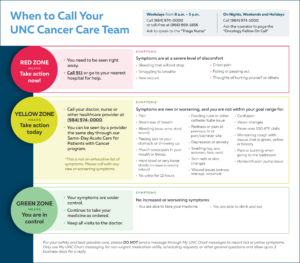When you are being treated for cancer, nothing feels “normal.” But what are the expected symptoms and side effects of the disease and its treatment, and when should you call your healthcare provider or 911?
It can be hard to know. To help people manage their symptoms and get care when they need it, the UNC Cancer Care team developed a simple three-category chart to help you know what to do. Symptoms can fall in the red zone (danger), yellow zone (caution) or green zone (all is well). (While this chart was developed at UNC Health, it can be useful to anyone anywhere who has cancer and wonders when to get help from their local cancer care team.)
Illnesses and infections can be more severe in people with cancer and need to be watched closely.
“When you are on chemotherapy, your immune system is weaker and you might get an infection more easily,” says Lee Dagenhart, RN, manager of the nurse navigation team for oncology at UNC Health. “Our goal is to keep patients out of the red zone—and out of the emergency room, where they have to wait and potentially be exposed to other infections.”
Patients and their caregivers should pay close attention to symptoms and monitor vital signs at home. Temperature is especially important because a high temperature can indicate an infection. Don’t wait to report a fever—any temperature 100.4 degrees or higher.
“Keep a reliable thermometer at home,” says Tammy Triglianos, DNP, a UNC Health gastrointestinal oncology nurse practitioner. “If you’re having symptoms or feeling bad, checking your temperature is a good place to start.”
How to Know When It’s an Emergency
Red-zone symptoms mean you need to act right away. Call 911 or go to the nearest hospital if you experience severe discomfort or any of the following:
- Bleeding that will not stop
- Difficulty breathing
- New seizure
- Chest pain
- Falling or passing out
- Thoughts of hurting yourself or others
Yellow-zone symptoms are not immediate emergencies, but you need to call your doctor or cancer care team the same day if you’re experiencing new or worsening symptoms, or if your symptoms are not within the goal range you discussed with your provider. For example, if your provider says it’s normal for you to be slightly short of breath while walking during your treatment, but you start to feel short of breath all the time, even at rest, you’ll want to notify your team.
You may need to be seen by a doctor, an advanced practice provider or a nurse on the day you call to report what is going on, or within the week. Yellow-zone symptoms can include pain, vomiting, confusion, bleeding, rashes, depression and problems with medical equipment, such as feeding tubes.
The green zone is where you and your cancer team want you to be. It means that your symptoms are under control, you can take your medicine and you are able to eat and drink.
Even when you are in the green zone, make sure you take your medications as prescribed and keep all your scheduled visits with your healthcare provider.
If you have any new or worsening symptoms while you are being treated for cancer, contact your doctor, cancer care team or oncologist on call. Call 911 for emergencies. If you need a doctor, find one here.

